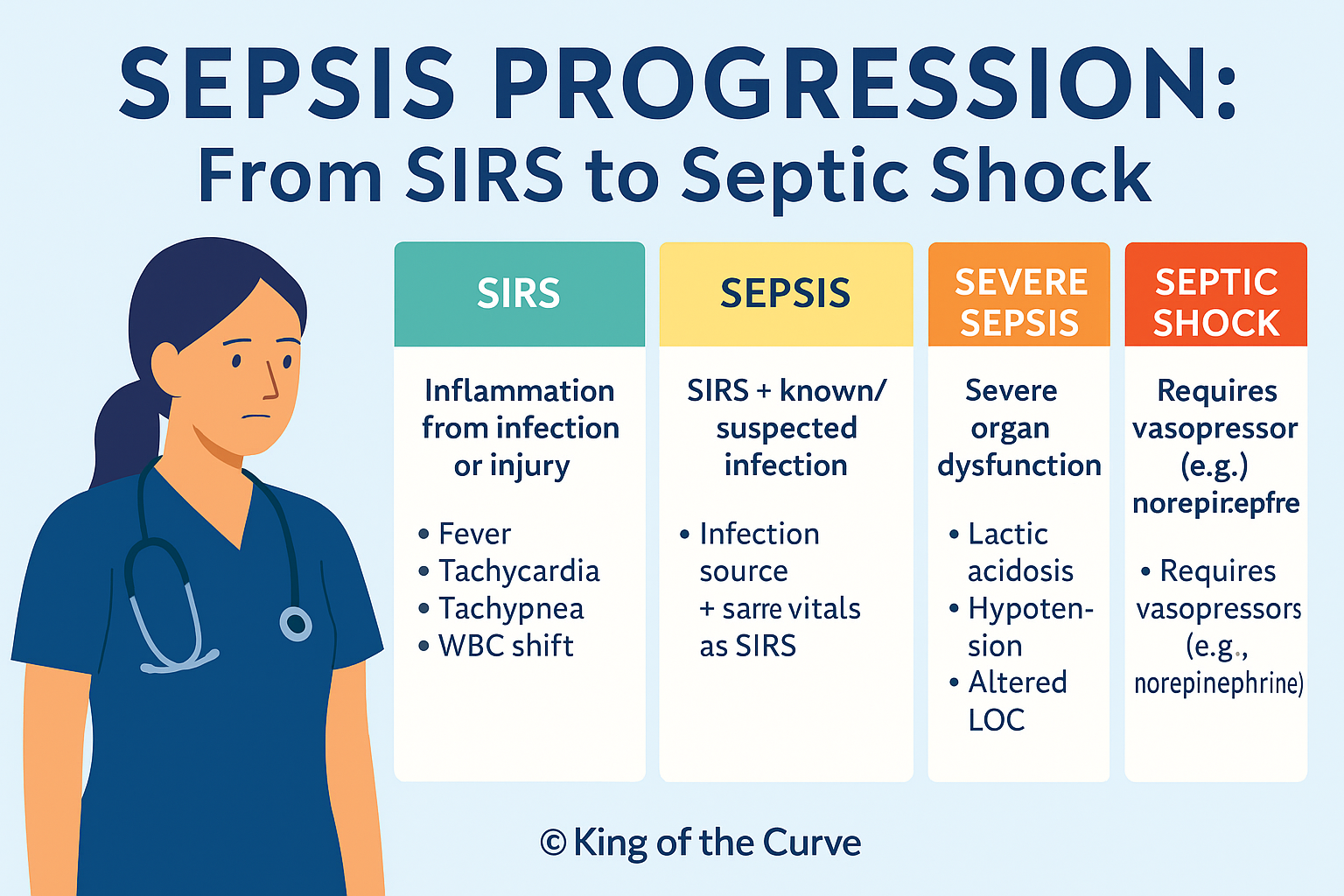🚨 NCLEX Sepsis Progression Guide: From SIRS to Septic Shock
Sepsis is one of the most high-stakes, high-yield concepts tested on the NCLEX. You’re expected to recognize early warning signs, understand the progression of systemic infection, and know what critical interventions to take at each stage.
This blog will break down:
The four clinical stages of sepsis
Nursing priorities for each step
NCLEX practice cues and red flags
A visual guide to sepsis progression
🩸 Stages of Sepsis & Clinical Signs
| Stage | Definition | Clinical Signs |
|---|---|---|
| SIRS | Systemic inflammatory response | Fever, tachycardia, tachypnea, WBC shift |
| Sepsis | SIRS + suspected or confirmed infection | Infection source + SIRS signs |
| Severe Sepsis | Sepsis + organ dysfunction | Hypotension, lactic acidosis, altered mental status |
| Septic Shock | Severe sepsis unresponsive to fluids | Requires vasopressors (e.g., norepinephrine) |
💡 NCLEX Tip: Know that blood cultures must be drawn before giving antibiotics.
🧠 Sepsis Mnemonic: "Time" to Act
T – Temperature abnormal (high or low)
I – Infection (confirmed or suspected)
M – Mental decline (confused, sleepy, difficult to rouse)
E – Extremely ill (dyspnea, mottled skin, low BP)
🛑 Nursing Interventions by Stage
| Stage | Top NCLEX Action |
|---|---|
| SIRS | Monitor vitals and labs |
| Sepsis | Start fluids + blood cultures + antibiotics |
| Severe Sepsis | Administer oxygen and assess for organ failure |
| Septic Shock | Initiate vasopressors and escalate to ICU |
🧪 Order of interventions: O₂ → Blood cultures → Broad antibiotics → IV fluids → Vasopressors
📝 NCLEX Practice Question
Q: A patient has fever, tachycardia, and confirmed pneumonia. BP is 84/56 despite 2L NS. What is the nurse's priority?
A. Call lab
B. Start vasopressors ✅
C. Increase fluids
D. Administer acetaminophen
Rationale: Unresponsive hypotension = septic shock, requiring vasopressors.
📌 Summary
SIRS → Sepsis → Severe Sepsis → Septic Shock
Recognize early signs of infection + systemic inflammation
Know which actions correspond to each stage
Timing of antibiotics, fluids, and vasopressors is crucial
📱 Study Smarter with King of the Curve
🔁 Free Trial Sessions
📊 Visual Concept Learning
🎁 Lifetime NCLEX Access
Frequently Asked Questions (FAQs)
-
Aim for 4-6 focused hours, ensuring you incorporate breaks to avoid burnout.
-
Practice mindfulness techniques, take practice exams under realistic conditions, and maintain a balanced lifestyle.
-
Set short-term goals, seek support from mentors, and reward yourself for small achievements.
-
Regular exercise improves focus, reduces stress, and enhances overall mental clarity.
-
KOTC offers personalized learning tools, gamification features, and adaptive question banks to help students stay on track without burnout.


